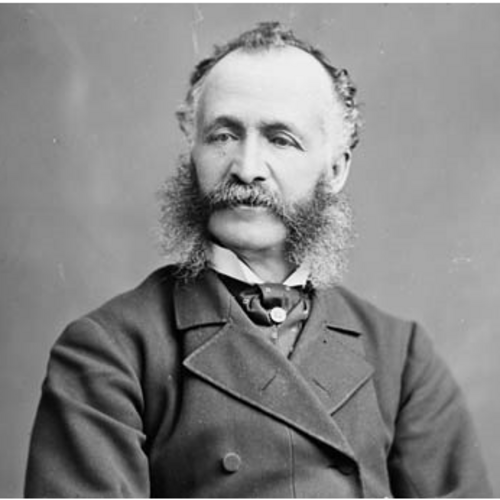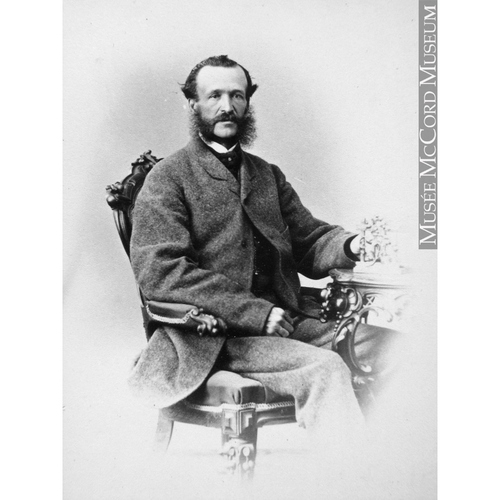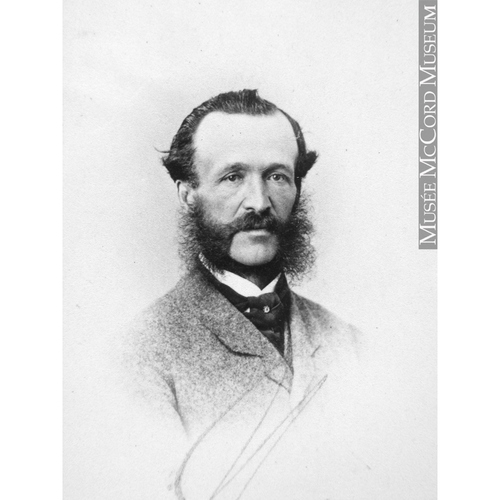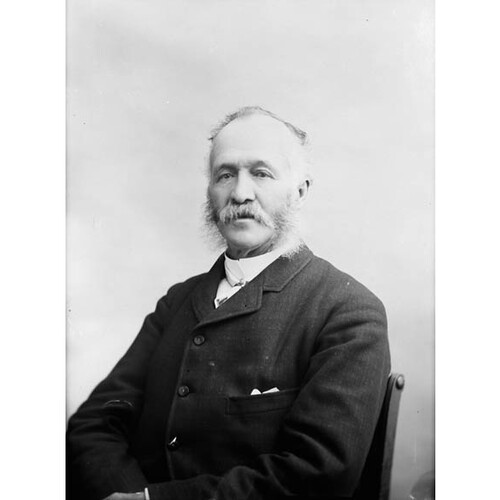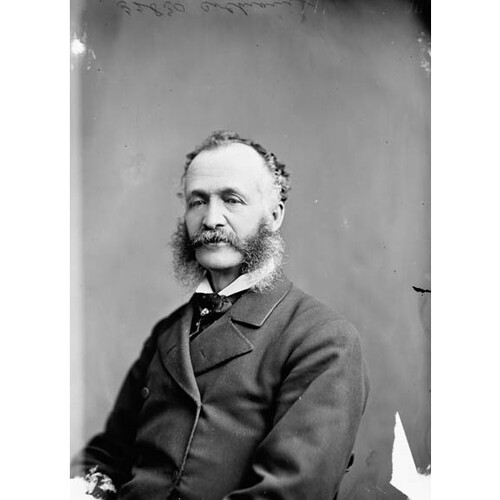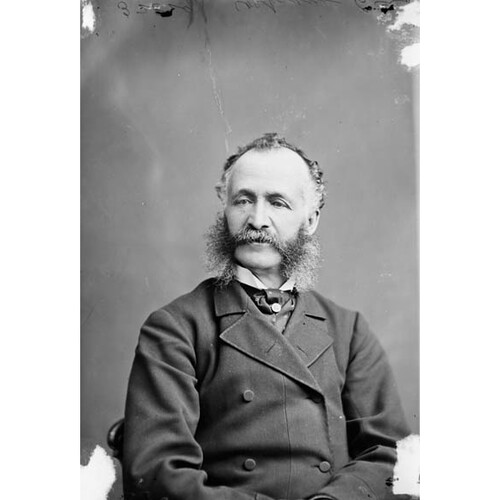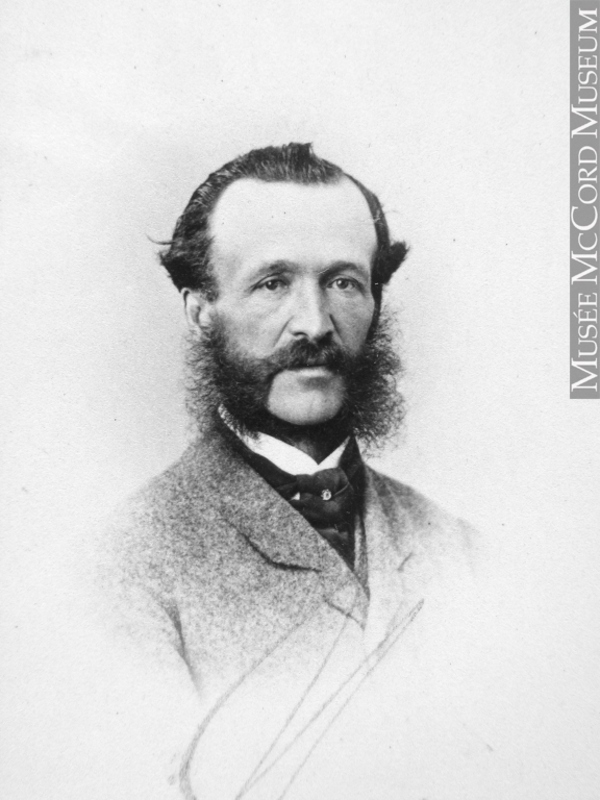
Source: Link
COCHRANE, MATTHEW HENRY, industrialist, livestock breeder, and politician; b. 11 Nov. 1823 in Compton, Lower Canada, son of James Cochrane, a merchant and farmer; m. 1849 Cynthia Maria Whitney of Lowell, Mass., and they had three sons and six daughters; d. 12 Aug. 1903 in Compton.
The eldest son of an Irish Anglican immigrant, Matthew Henry Cochrane belongs to that group of Canadian entrepreneurs who, by their influence and their field of action, illustrate the workings of industrial and agricultural capitalism in Montreal, the Eastern Townships, and the prairies of western Canada. Their activities demonstrate how important it was to use both overseas and North American resources at the appropriate times.
Cochrane had the advantage of doing his commercial and industrial apprenticeship in one of the main North American centres of the industrial revolution. From 1841 to 1854 he worked in the Boston area, where he acquired not only enough capital to set up a footwear factory in Montreal, but also invaluable familiarity with the most recent features of the American manufacturing sector. Starting out in partnership with Samuel G. Smith, whose customers came from as far away as Compton county, Cochrane assembled an initial capital of $9,000 and in 1854 founded a boot- and shoe-manufacturing business whose value increased rapidly to $80,000 five years later. The factory, at the corner of Rue Latour and Rue Sainte-Geneviève, had 300 men and women as employees and an annual output worth $200,000. At the time it was one of the largest footwear outfits in Canada. Its turnover doubled during the next two decades and then levelled off until the end of the century. Following Smith’s death in 1868, Cochrane had formed a new partnership with Charles Cassils, a young Scottish immigrant to whom he gave the hand of one of his daughters in marriage in 1876.
Like the great majority of Canadian footwear manufacturers, Cochrane made no attempt to invest his profits in tanning or leather-finishing operations, which could supply his factory. In 1864 he chose instead to buy a large agricultural property near his father’s farm in Compton county. Using the capital he had accumulated in the shoe industry, he built up his farming enterprise by investing unprecedented sums to import purebred livestock from the British Isles. In 1870 he bought 63 head of cattle bred from the famous Wetherby and Warlaby Shorthorn lines in Cumberland and Yorkshire. By this investment of about $60,000 Cochrane acquired the largest purebred herd yet brought into Canada by one person. His property was a veritable agricultural empire, growing in a short time to 750 acres with 478 head of livestock, as well as some 300 animals sold or slaughtered during a single census year. His farm, on which 13 employees lived in 1871 (including a housekeeper, a nurse, and a cook), expanded to 1,100 acres a few years later, making Cochrane the biggest landowner in the county. Thanks to its international reputation, the Hillhurst estate sold its livestock all over the continent and Cochrane also found buyers among British breeders. He again created a sensation in 1876 when he sold five purebred Shorthorns for a record price of £203 14s. each.
Over the years Cochrane the industrial and agricultural entrepreneur diversified his field of investment. He held executive office in the Canada Agricultural Insurance Company, the Canadian Meat and Produce Company, the Tolley Manufacturing Company, the Waterloo and Magog Railway, and the Bigelow Company. He was vice-president of the Eastern Townships Bank, and was on the boards of Bishop’s College in Lennoxville, the Compton Ladies’ College, and the Sherbrooke Protestant Hospital. Cochrane also made a breakthrough into politics on 17 Oct. 1872, when he was appointed to the Senate for the division of Wellington.
Cochrane was to admit in 1896 that he had taken the floor in the Senate only once or twice in nearly a quarter of a century. Prestigious though the position of senator was, his appointment would probably have had no historical significance if he had not been a moving force behind a large wave of investment in livestock breeding in western Canada. In 1880–81 he submitted to Sir John A. Macdonald*’s cabinet recommendations that had a profound influence on the method of granting crown lands for grazing on the prairies of southern Alberta. In the United States grazing rights were usually granted once a particular tract was occupied, but Cochrane declared that in the Canadian context large sums could not be successfully invested without better guarantees from the state. Despite set-backs, he attained his main objectives: in December 1881 a minister’s order set aside up to 100,000 acres of pasture land per breeder, for a period of 20 consecutive years at a modest annual rental of ten dollars per thousand acres; it also exempted ranchers from paying duty on cattle imported from the American prairies.
The establishment of the Cochrane Ranche Company Limited, which had been founded a few months earlier with Cochrane as president, marked the beginning of a process that would see western livestock ranching consolidated into some 50 large operations by about 1890. With 204,500 acres of rented land and 10,433 head of livestock, the company ranked second, behind the British-financed Walrond Ranche Company. It owned four ranches, had a total capital of $500,000, and brought together a number of important business leaders, including George Alexander Drummond and Louis-Huet Massue. Senator Cochrane also presided over the formation of the British North American Ranche Company, which specialized in raising sheep in the Bow River valley west of Calgary.
Since he had paid particular attention to the British market, Cochrane was seriously affected by the embargo placed on Canadian livestock by the British government in 1892 because of an outbreak of disease. The decline in exports forced many western breeders to operate in a buyer’s market dominated more and more by Patrick Burns* in Calgary and by Gordon, Ironside, and Fares in Winnipeg [see Robert Ironside]. The livestock breeding companies of which Cochrane was president were dissolved shortly after his death and his western property of more than 60,000 acres was purchased by some Mormons for six dollars an acre. It was not long before the principal heir, James Arthur Cochrane, also sold his father’s estate in Compton county, in order to settle comfortably in Lennoxville and later in Westmount. Despite its solid base, the empire built up by Matthew Henry Cochrane did not outlast its founder.
AC, Saint-François (Sherbrooke), État civil, Anglicans, St James (Compton), 14 Aug. 1903. Baker Library, R. G. Dun & Co. credit ledger, Canada, vol.5. NA, RG 31, C1, 1825, 1871, Compton county; 1861, 1871, Montreal, West Ward. Gazette (Montreal), 13 Aug. 1903. La Presse, 13 août 1903. Boston directory . . . (Boston), 1842–54. D. H. Breen, The Canadian prairie west and the ranching frontier, 1874–1924 (Toronto, 1983). G. L. Burton, “The early development of cattle ranching in Alberta,” Economic Annalist (Ottawa), 11 (1941): 41–46. Can., Parl., Sessional papers, 1877, no.8; Senate, Debates, 1896. Canadian biog. dict. Canadian men and women of the time (Morgan; 1912). L. S. Channell, History of Compton county and sketches of the Eastern Townships, district of St. Francis, and Sherbrooke county (Cookshire, Que., 1896; repr. Belleville, Ont., 1975). CPG, 1879. Directory, Montreal, 1898–99. Jacques Ferland, “Évolution des rapports sociaux dans l’industrie canadienne du cuir au tournant du 20e siècle” (thèse de phd, McGill Univ., Montréal, 1985). History of Short-horn cattle imported into the present Dominion of Canada from Britain and United States, chronologically arranged (n.p., [1894?]). Illustrated atlas of the Dominion of Canada . . . Eastern Townships and south western Quebec (Toronto, 1881; repr., ed. Ross Cumming, Port Elgin, Ont., 1972). J. I. Little, “The social and economic development of settlers in two Quebec townships, 1851–1870,” Canadian papers in rural history, ed. D. H. Akenson (8v. to date, Gananoque, Ont., 1978– ), 1: 89–113. A. H. Sanders, Short-horn cattle; a series of historical sketches, memoirs and records of the breed and its development in the United States and Canada (2nd ed., Chicago, Ill., 1901). Terrill, Chronology of Montreal.
Cite This Article
Jacques Ferland, “COCHRANE, MATTHEW HENRY,” in Dictionary of Canadian Biography, vol. 13, University of Toronto/Université Laval, 2003–, accessed April 11, 2025, https://www.biographi.ca/en/bio/cochrane_matthew_henry_13E.html.
The citation above shows the format for footnotes and endnotes according to the Chicago manual of style (16th edition). Information to be used in other citation formats:
| Permalink: | https://www.biographi.ca/en/bio/cochrane_matthew_henry_13E.html |
| Author of Article: | Jacques Ferland |
| Title of Article: | COCHRANE, MATTHEW HENRY |
| Publication Name: | Dictionary of Canadian Biography, vol. 13 |
| Publisher: | University of Toronto/Université Laval |
| Year of revision: | 1994 |
| Access Date: | April 11, 2025 |


